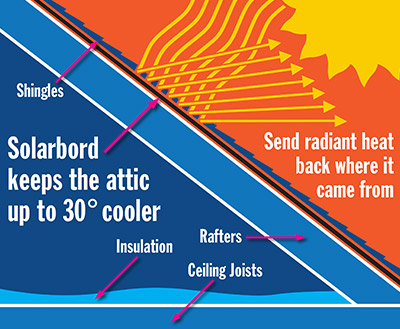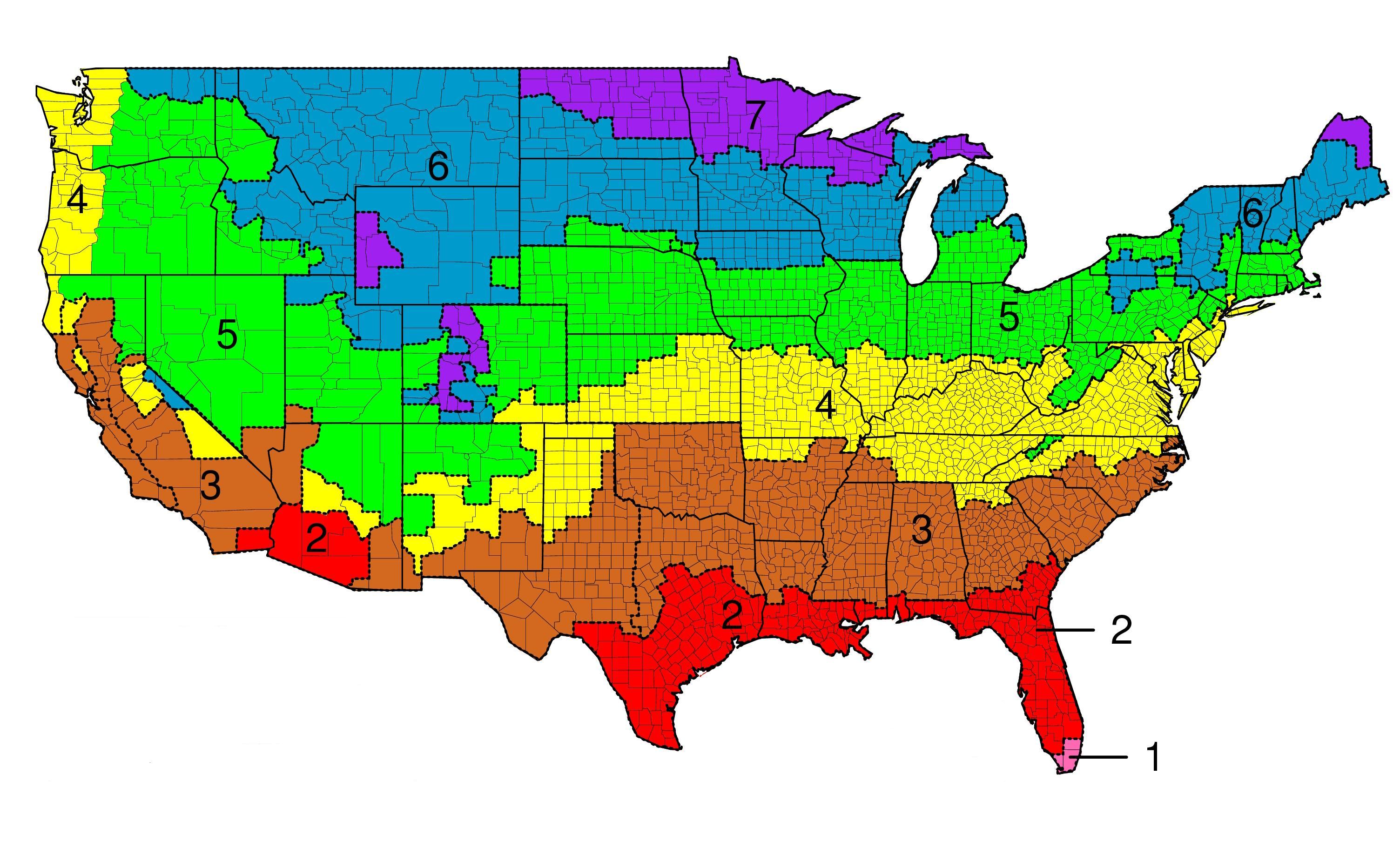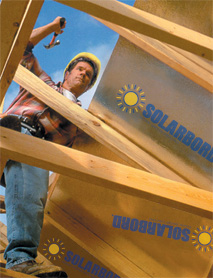- Which way should SOLARBORD face?
- How does SOLARBORD reflect the heat if it faces down?
- How does SOLARBORD save money?
- Will SOLARBORD damage my shingles?
- Will SOLARBORD affect the reception performance of an antenna or satellite dish mounted in the attic?
- Should SOLARBORD be installed on gable walls?
- Can SOLARBORD be installed only on specific portions of the roof?
- Can other materials such as spray foam be installed against SOLARBORD in the attic?
- How long will SOLARBORD provide a radiant thermal shield before I need to replace it?
- Is it possible to estimate the energy and cost savings I can expect with SOLARBORD?
- What is the R-value of SOLARBORD?
- What benefits does SOLARBORD provide that fiberglass does not?
- Will the benefits of SOLARBORD be the same when I replace my cedar shingle roof?
- Can I accomplish the same result with improved attic ventilation?
- Can SOLARBORD be used for wall sheathing?
Which way should SOLARBORD face?
In order to block the radiant energy from your hot roofing materials, the foil side of SOLARBORD must face the attic space. The high purity aluminum (99+%) laminated on SOLARBORD requires an air space in order to provide radiant thermal shield benefits. SOLARBORD must not be installed with foil side in contact with the roofing materials.
Top
How does SOLARBORD reflect the heat if it faces down?
The aluminum that is laminated to SOLARBORD reflects radiant energy very efficiently and it does not radiate heat very well. The fact that the foil faces the attic creates the air space required for a radiant thermal shield to function. Because it is installed in the matter, SOLARBORD will reflect up to 97% of the radiant energy that ordinarily is transmitted to your attic interior. An additional benefit of facing the foil down is that fact that it does not gather dust which can limit the effectiveness of a radiant thermal shield.
Top
How does SOLARBORD save money?
The savings are achieved through a combination of several related physical changes impacting the radiant energy in your home and the systems used to cool it. Essentially, the savings are achieved by reducing the amount of electricity consumed by your HVAC system to maintain the comfort level you desire.
A reduced attic air temperature results from lower amounts of radiant energy entering the attic space.
Lower attic air temperature and decreased levels of radiant energy lowers the surface temperature of the fiberglass insulation, which in turn reduces heat transfer through the ceiling into the living space.
Additionally, because the fiberglass absorbs less radiant heat, the house cools down quicker in the early evening.
Because of the effect of the first three items, less heat is transmitted by the interior ceiling, the occupants of the house absorb less radiant energy (heat), and feel a comparable degree of comfort at a higher thermostat setting.
And finally, for those homes with duct work in the attic, SOLARBORD provides an environment of lower operating temperatures which translates to a more efficient air conditioning system.
Top
Will SOLARBORD damage my shingles?
No. there are a wide range of mechanisms at work which dissipate the heat blocked by SOLARBORD. Studies have shown that shingle temperatures only rise approximately 2-5°F using SOLARBORD and remain well within the 200°F shingle temperature that most shingle companies warrant.
Top
Will SOLARBORD affect the reception performance of an antenna or satellite dish mounted in the attic?
Yes. SOLARBORD will interfere with reception quality when antennas or satellite dishes are mounted in the attic. Exterior mounted antennas and satellite dishes are recommended.
Top
Should SOLARBORD be installed on gable walls?
Yes. Gable walls are also an area that allows radiant energy to enter the house. Utilizing SOLARBORD in this application only adds to the benefits that existing SOLARBORD roof sheathing provides. Here again, the foil side of the board should face the attic.
Top
Can SOLARBORD be installed only on specific portions of the roof?
Although some benefit will be derived by a partial installation of SOLARBORD, this is not recommended. Your benefit will be proportional to the amount of the roof area in which SOLARBORD is installed. Full benefit requires a complete envelope of the aluminum surface, including gables.
Top
Can other materials such as spray foam be installed against SOLARBORD in the attic?
No. An airspace must exist on the foil side of SOLARBORD in order to achieve radiant thermal shield benefits. Spaying foam over the full surface will totally negate any benefits of the radiant barrier.
Top
How long will SOLARBORD provide a radiant thermal shield before I need to replace it?
One of the best features of SOLARBORD is that it does not require any maintenance, and its effectiveness does not deteriorate over time.
Top
Is it possible to estimate the energy and cost savings I can expect with SOLARBORD?
The impact of SOLARBORD (much like conventional insulation) depends upon the climate, and the heating and cooling habits of the homeowner. It is possible to make general estimates using average climactic data for an area, assuming average desired interior temperatures, and local electricity rates. A sophisticated computer modeling program has been used to refine these estimates. However, due to the inexpensive nature of installing SOLARBORD, even with very conservative savings estimates, SOLARBORD will save you money. This is particularly true if your home is mortgaged, and the incremental expense is spread over the life of the mortgage. In these cases the savings go in your pocket starting the first month you own the home. Your SOLARBORD representative can work with you to estimate these savings.
Top
What is the R-value of SOLARBORD?
R-value by definition measures the resistance for heat flow. It is a measure designed to evaluate the benefits of mass insulation through testing. As SOLARBORD is a Radiant Thermal Shield, the use of a mass insulation measurement will result in no true R-value. The benefits of SOLARBORD can be measured based on reduced heat flux, decreased energy consumption, and decreased surface temperatures of the contents of the shielded area. The estimated savings and effectiveness can be accurately calculated using sophisticated computermodeling programs in compliance with ASTM C1340.
Top
What benefits does SOLARBORD provide that fiberglass does not?
There are three types of Heat Flow into your home:
- Conduction – Heat Flow through a solid (building material)
- Convection – Heat Flow by air movement
- Radiation – Heat Flow radiated through air by a hot solid (roofing materials and ceilings)
Fiberglass primarily slows heat flow by conduction and to a small degree by convection. Mass insulation does not reduce radiation in fact it absorbs it. SOLARBORD on the other hand blocks 97%* of the radiant heat generated by your hot roofing materials. This in turn lowers the amount of radiant heat that is absorbed by the surfaces of both your HVAC equipment, and the fiberglass insulation. This allows HVAC system to operate more efficiently, and the fiberglass insulation to be more effective at slowing the transfer of heat into the living space. SOLARBORD is not recommended as a substitute for conventional fiberglass insulation. It simply works in partnership with fiberglass and other conventional insulation to improve effectiveness.
Top
Will the benefits of SOLARBORD be the same when I replace my cedar shingle roof?
All radiant barriers require a minimum of ¾” air space from the foil surface. Removing all the “space sheathing” boards will allow the SOLARBORD to provide maximum benefits. If all or some of the boards are left in place the effectiveness will be reduced by the amount of foil area in contact with the boards. E.g. if half the foil surface is in contact with another surface the benefits will be reduced by approximately that amount. Removing all the “space sheathing” boards is the best practice. Another aspect to keep in mind is that a Cedar shingle roof typically keeps an attic cooler than an asphalt roof. SOLARBORD fastened directly to the rafters will likely provide a cooler attic than a cedar roof but it is unlikely to see a major drop in attic temperatures. Replacing a cedar roof with asphalt roofing alone could result in a big jump in attic temperatures unless a radiant barrier is used.
Top
Can I accomplish the same result with improved attic ventilation?
No. Even though improved ventilation will lower the air temperature in your attic, this will not produce significant reductions in energy usage. This is because the radiant heat will continue to pass through the air space and heat the surface of the insulation. This radiant heat will in turn be transferred through the insulation to the living space. SOLARBORD works by stopping 97%* of the radiant heat from entering the attic. Performance of SOLARBORD and your ventilation system will be improved by using the combination of products. As with any energy saving systems or materials, and initial investment will improve the comfort levels in your home, and produce energy and economic savings for years to come.
Top
Can SOLARBORD be used for wall sheathing?
A minimum of 3/4″ air space must be maintained in front of the foil surface for any radiant barrier to work. If the foil faces the inside of the building it will be very difficult to ensure there is the required air space between the foil and the insulation so in wall applications it is best to install the foil facing out. To maintain the required 3/4″ airspace strapping/furring strips must be installed to the foil side. Install the house wrap (if required by your local building code) on the outside of the strapping/furring strips. The wood strips will create the required air space depth and then the finished siding can be installed.
Notes:
- SOLARBORD is not considered a house wrap or moisture barrier.
- The extra thickness resulting from the strapping/wood strips may impact the window and door frame depths.
- Any spacing at the top and bottom of the wall created by the extra depth may require the steps to prevent insects, etc. from getting behind your finished siding.
- Be sure your finished siding is acceptable over this method.
Top




